What is a galaxy?
The cosmos reveals a hierarchy of structures, where smaller building blocks are combined to form larger ones. One of these cosmological building blocks is a galaxy. To be able to introduce extragalactic astronomy, and what it can tell us about our place in the cosmos, we start with the concept of galaxies. The question of what we define to be a galaxy is easiest to approach if we start at a place we all know: planet Earth.
The Solar System
From Earth, the Sun is by far the brightest astronomical source in the sky, across almost the entire range of wavelengths in the electromagnetic spectrum. As far as celestial objects go, many of us are probably most familiar with this star. Perhaps it is even so pervasive in our daily lives that we might forget to classify it as such. Deified and worshipped since ancient times, it outshines all other objects, which we normally cannot observe until nighttime.
When night does come, the Earth is shading us from the Sun, and with the naked eye we can start to make out other planets and stars. Earth and its seven sister planets, plus many other smaller objects orbiting the Sun,1 make up the Solar system. The distance from Earth to the Sun, approximately 150 million kilometres, is defined as an Astronomical Unit (AU). For example, the outer-most known planet, Neptune, orbits the Sun at about 30 AU. The image below faithfully replicates the relative distances between the planets, but their sizes are enlarged on purpose: it is almost impossible to replicate the Solar system to scale. When imagining a scale model with the Sun shrunken to the size of a tennis ball, Earth would be seven metres away, only the size of the tip of a sewing pin, while Pluto can be up to 350 metres (more than three football pitches2) away.
This is a short overview of the field of extragalactic astronomy, with a focus on observations of the first galaxies in the Universe. It discusses our current best understanding, the motivation behind studying these objects, and the basis of observational methods.
1 These objects, gravitationally bound to the Sun like the planets but typically much lighter and smaller, include comets, asteroids, and of course Pluto, which is currently classified as dwarf planet.
2 Regardless of which type of English you prefer.

Nearby stars
Proxima Centauri, the closest star after the Sun, is 4.25 lightyears away, meaning its light takes just over four years to reach us.2 This astonishing distance corresponds to nearly 40 trillion kilometres, which is roughly 266940 AU – or about 2000 kilometres in the scale model described above! But it hardly stops there: other stars in the night sky can easily be thousands of lightyears away. Only in the last few decades, we have learnt that these distant stars can harbour their own planets, too. Since they are not part of our Solar System, they are called extrasolar planets or exoplanets in short.
2 The crucial fact that light requires a finite time to traverse space will be discussed in more detail below.
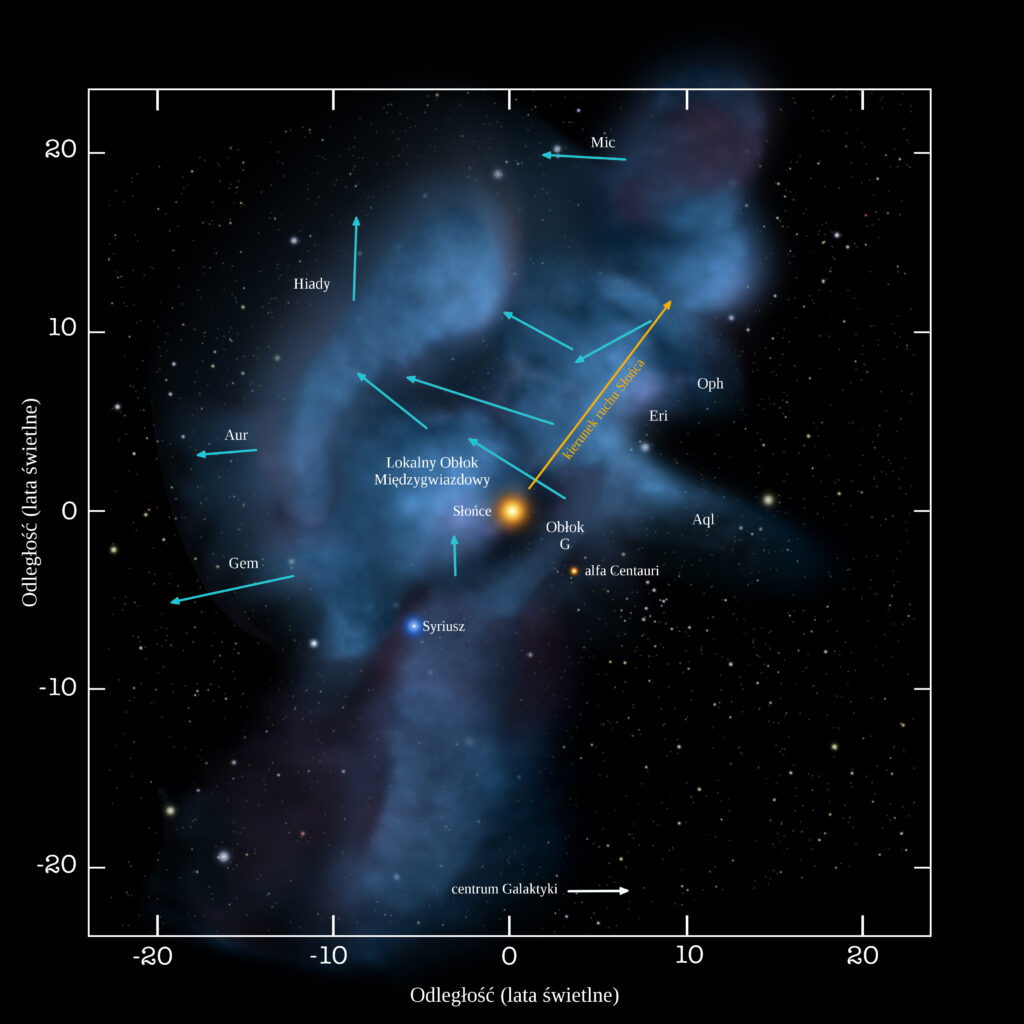
The Milky Way
Making another big jump in distance scales, we finally arrive at the concept of a galaxy. The one our Solar system is contained in is the Milky Way (see, for example, this visualisation). To us, it is visible on clear nights as a hazy, white band of light.3 By galaxy, we mean the complete collection of stars, but also stellar remnants, gas, dust, and dark matter. It is the first step on the hierarchical ladder of cosmological structures: systems of stars, many of them with accompanying planets (or indeed stars, in so-called binary-star systems), together form the individual building blocks of a greater structure, the galaxy. The Milky Way is thought to have a total mass of about 1.5 trillion times that of the Sun, according to estimates (roughly 90% in the form of dark matter). Located in one of the spiral arms, the Solar system (in its entirety) orbits its centre that is about 26000 lightyears away (corresponding to an unfathomable 12 million kilometres even in our scale model from before), as shown in the artist’s impression below.
3 Hence its name, which traces back to the ancient Greek γαλαξίας κύκλος or literally ‘Milky Circle’. This also reveals the origin of the generic term galaxy.
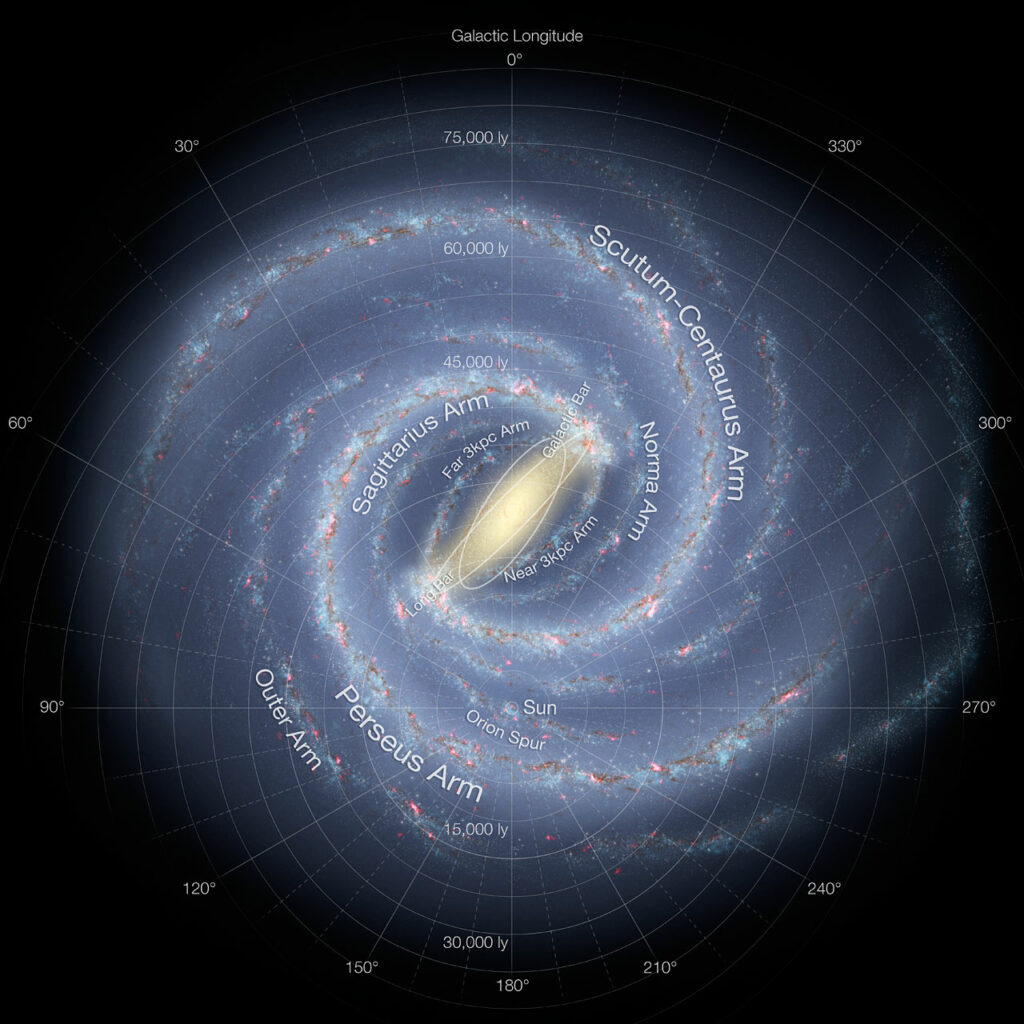
Spiral nebulae
The understanding behind the structure of the Milky Way, and our place within it, has (in part) been established from studies of what were initially called spiral nebulae, but we now recognise as distant galaxies,4 many containing billions of stars like the Milky Way. The field of extragalactic astronomy, studying the Universe beyond our own Milky Way, emerged about 100 years ago and has identified a great number of them: in a few years from now, astronomers are estimating to chart about 20 billion (more than twice the number of people on Earth!) of them using the Vera C. Rubin telescope. Observations reveal a wealth of different types with varying observed colours, shapes, and sizes (see below).5 The nearest galaxy is the Andromeda galaxy, at about 2.5 million lightyears away.
4 They are distinct from nebulae inside the Milky Way that can be stellar nurseries or, in contrast, the signs of a dying star: planetary nebulae can form near the end of its life, supernova remnants are what remains after a violent explosion that marks the end of a massive star’s life cycle. Stellar formation and evolution are described in more detail below.
5 You can see many more beautiful images of galaxies, and even help identify their types via the Galaxy Zoo Project.
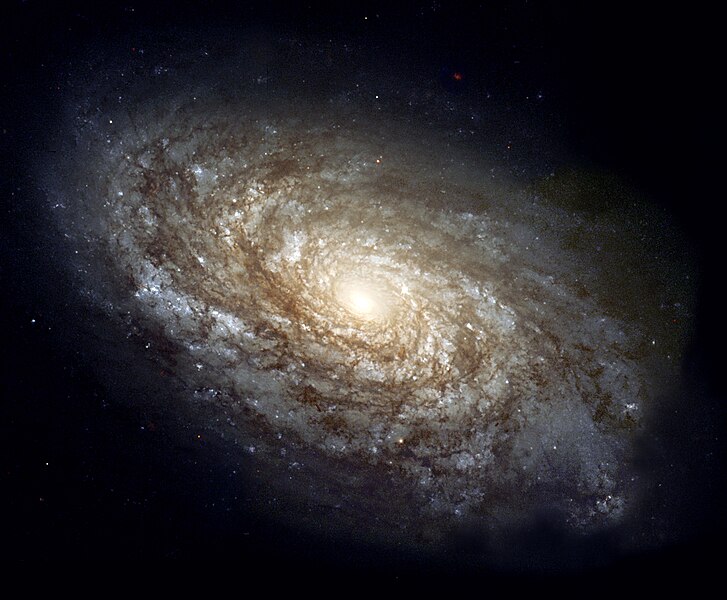
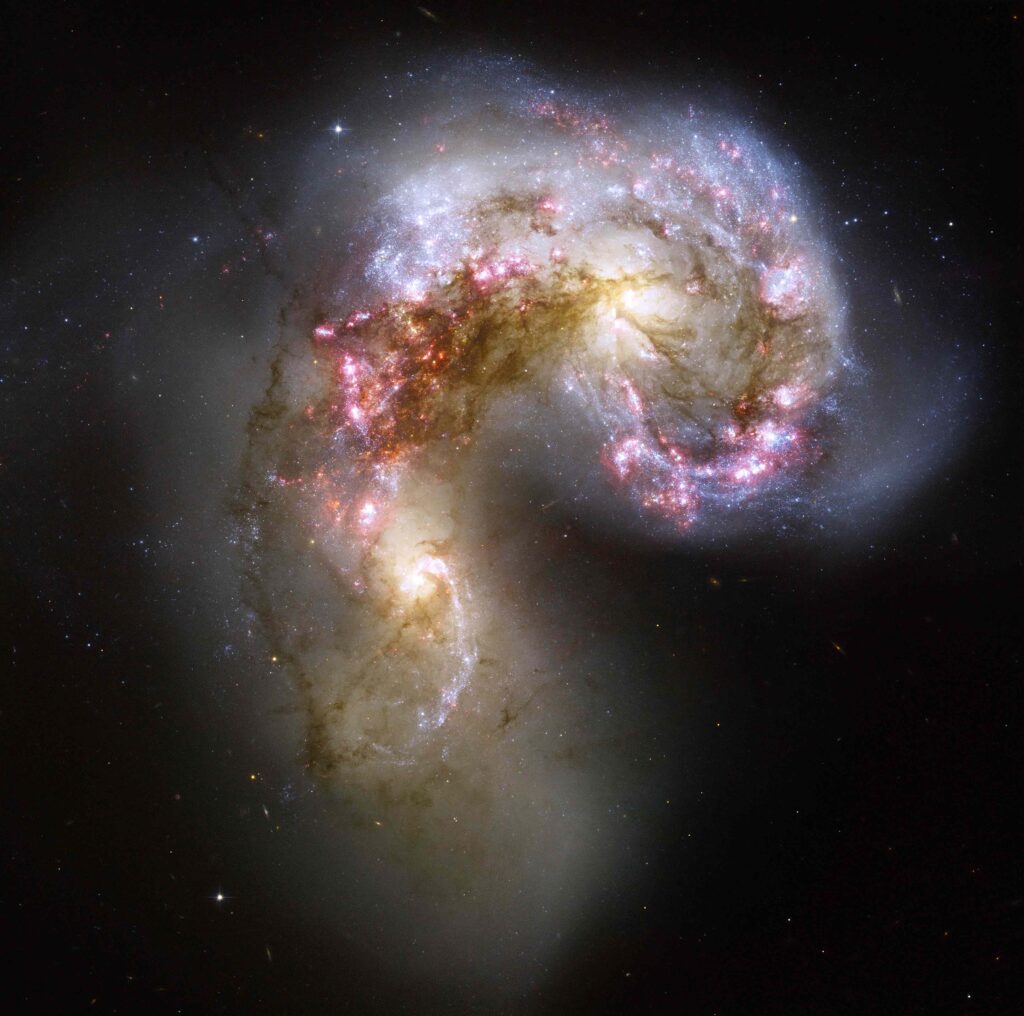
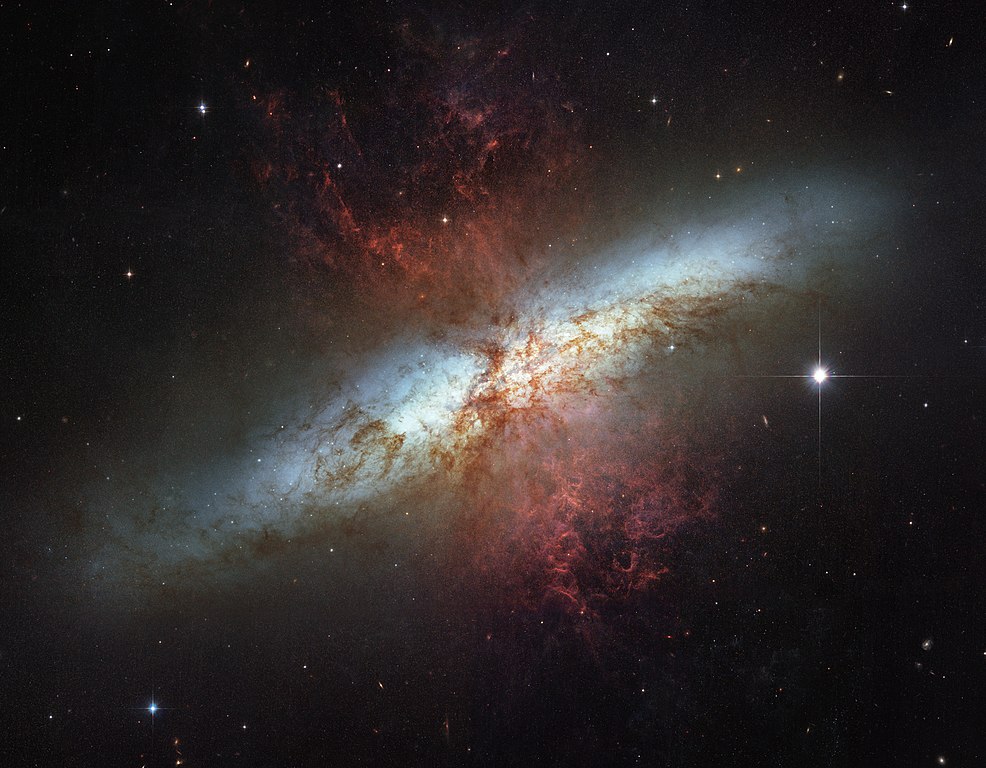
A timeline of the Universe
Cosmic relics
The earliest image of the Universe is visible to us as the Cosmic Microwave Background (CMB), in some sense the ‘afterglow’ radiation of the Big Bang, the beginning of the Universe. This radiation is the oldest detectable light signal, from when the Universe had just cooled down enough for neutral atoms to form. Up to this point, it had been so dense and hot that all matter formed a “primordial plasma”, neutral on the whole, but microscopically consisting of electrically charged protons and electrons (and neutrons which, as their name suggests, have zero charge). Together, these subatomic particles can form atoms, and therefore make up all the elements such as hydrogen, carbon, and oxygen. When separated, however, they interact strongly with light (a process called scattering). When the Universe had cooled down sufficiently, pairs of a single proton (the atomic nucleus of hydrogen) and a single electron could combine into stable hydrogen atoms, turning all particles neutral.6
This drastic event called recombination7 happened just under 400000 years after the Big Bang, the cosmic blink of an eye compared to the Universe’s current age of 13.8 billion years. Now that the Universe did not contain freely floating charged particles, photons (particles of light) could travel without any obstacles, causing quite a sudden release of light. The radiation itself, still red-hot when released (at around 3000 Kelvin), has since cooled down with the expansion of the Universe – a truly tricky concept to wrap your head around, leading to other surprising effects8 – and is now brightest at microwave wavelengths, corresponding to a mere 3 degrees above absolute zero (2.7 Kelvin, to be precise).
Observed today as the CMB, it provides us a ‘snapshot’ of the Universe’s thermal state at the time of recombination, when it was released. It shows us that the entire Universe, even regions opposite each other in the sky, had a remarkably similar temperature. Minuscule variations (see image below) are thought to arise from quantum fluctuations imprinted during a process called inflation just fractions after the Big Bang,9 and are predicted to form the seeds of the largest cosmic structures in place today – including the structure the Milky Way, and therefore our Solar system and planet Earth, resides in.
6 There was also a small fraction of helium (about 8% of all atoms), which instead consists of a nucleus of two protons and two neutrons, and two electrons.
7 As it marks the phase transition combining protons and electrons. Confusingly, there is no reason for it to be called recombination, suggesting they had been combined before: these were the very first neutral atoms ever to be formed. The term Reionization (a process introduced before long) on the other hand is consistent, as it returned the Universe to its initial, ionised state.
8 The Universe’s expansion also caused it to cool in the first place. Its other important effect, which is to cool down radiation like the CMB, astronomers refer to as cosmological redshift, and will be discussed further below.
9 Alternative theories exist, which for example argue they should instead be explained by the relics of an ancient aeon that existed before the Big Bang, within a theoretical framework called Conformal Cyclic Cosmology.
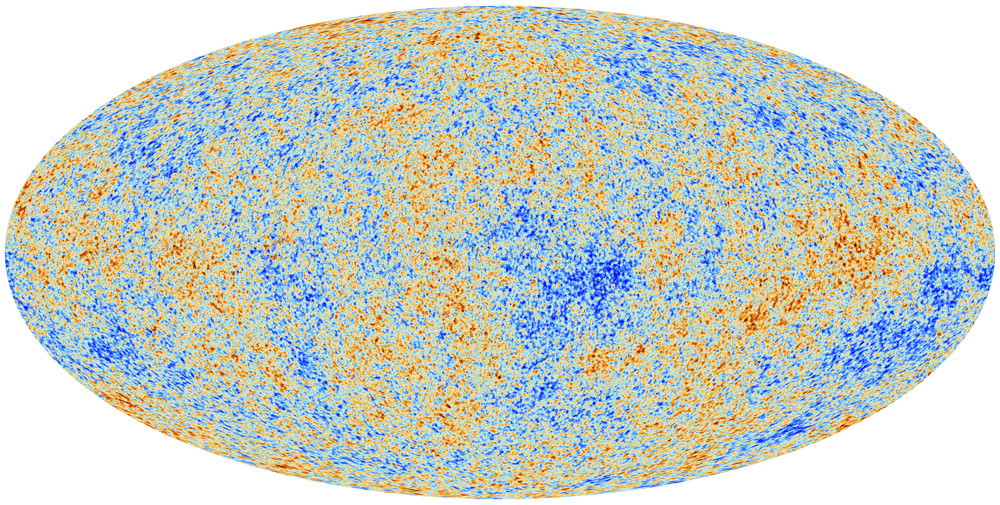
The first stars and galaxies
After recombination, the Universe entered a period called the Dark Ages, to highlight the contrast with the period to follow: Cosmic Dawn,10 which saw the formation of the first stars, and subsequently the first galaxies. Stars are formed when a gas cloud becomes sufficiently dense for it to collapse under its own gravity. The star is stabilised by the onset of nuclear fusion in its incredibly dense and hot core, generating an enormous amount energy that prevents its further collapse and is then radiated away: this is what causes a star to shine. Stars like the Sun can live billions of years, while more massive stars burn their fuel relatively quickly. The most massive stars then end in spectacular supernova explosions, polluting its surroundings with the products of its nuclear fusion as well as newly produced heavy elements.11
From this point, starlight would illuminate the Universe, contributing to reionise (ionise means to strip an atomic nucleus from its electrons) the then neutral Universe with ultraviolet (UV) light. During this Epoch of Reionization (see schematic overview below), protons and electrons that had earlier formed neutral hydrogen atoms were split up once again by these energetic UV photons – another important cosmic milestone, as this meant ultraviolet light could now (almost) travel unimpeded without being absorbed by any intervening neutral hydrogen. In addition, the UV photons that were energetic enough to ionise hydrogen often had some excess energy, which significantly heated the intergalactic medium, the enormous gas reservoirs between galaxies (which at this point started forming stars rapidly) that provide fuel for the next generation of stars to form.
10 There is also a Cosmic Noon, which is used to refer to the peak of star formation roughly 10 billion years ago, when the Universe was ‘only’ about 3 billion years old. We could therefore call the present day Cosmic Afternoon.
11 You can also call it enriching: all the carbon and oxygen that we are made of – most elements other than hydrogen or helium, in fact – were originally formed and distributed by stars in this way, inspiring the famous Carl Sagan quote “We are made of star stuff.”
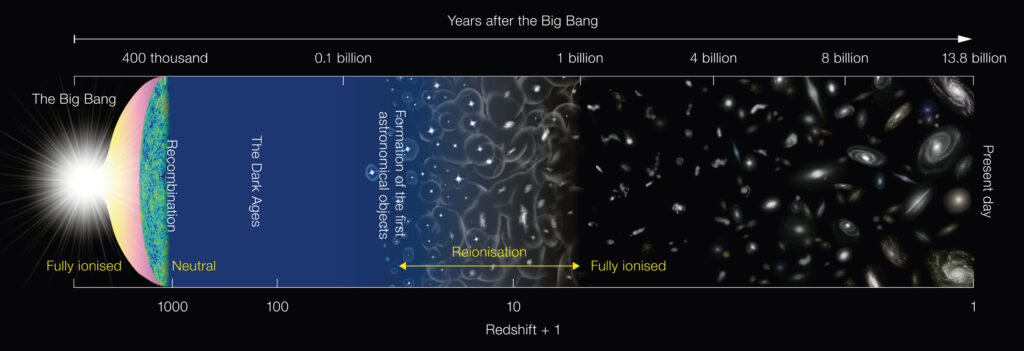
Over the last few decades, astronomers have kept pushing the observational boundaries with increasingly powerful telescopes, and started collecting larger and larger samples of galaxies in the very early Universe. The main reason for studying these galaxies is twofold. First, they are tied to the process of Reionization described above, whose main contributors are thought to be star-forming galaxies,12 but other exotic objects like Active Galactic Nuclei (AGN) could also be responsible for emitting (part of) the required UV radiation. Second, the first galaxies form the crucial link between two extremes: the CMB, the oldest light signal in the Universe, and observations of local galaxies. The two ends show strikingly different pictures, with one showing evidence for an almost perfectly smooth Universe, while the other instead reveals incredibly rich structures consisting of galaxies, the elemental cosmic building blocks.
12 Or, more specifically, their young, massive stars: remember that these burn their fuel more quickly, and emit more energetic photons as they are hotter.
How do we learn about the first galaxies in the Universe?
Observational methods
There are two key laws of physics that help us to see and identify the light of the first galaxies. First of all, as already mentioned, the speed of light is finite. Comparable to sound waves – if a lightning storm is 10 km away, the crash of thunder takes 30 seconds to reach us – light waves travel at a high, but finite, speed. Light from the Sun, for example, takes over 8 minutes to reach Earth, while light from the Andromeda galaxy (given its distance of 2.5 million lightyears) travels for 2.5 million years. This implies the more distant a source is, the further we are looking back in time, and it is for this reason that, in principle, we can trace back the entire history of the Universe if only we look at sufficiently faraway objects. (Naturally, this is very challenging in the Dark Ages, before any stars had formed.)
Secondly, the Universe is expanding. This causes distant objects to appear to be moving away from us,13 and their emitted light to shift in colour, from blue to red wavelengths. This effect, called the cosmological redshift, is precisely how the CMB has cooled. Comparing it to sound waves again, this effect is not unlike the change in tone you hear when an ambulance is driving away from you as opposed to moving towards you (in that case called the Doppler effect). Conveniently, the degree of redshift in the emitted light of a given source can quite accurately be established by certain redshifted spectral signatures.14 This quantity is itself called the redshift of an object and is denoted by \(z\). If you know how quickly the Universe has expanded since the light was emitted, it is possible to work out the distance between us and the object from its redshift.
Ongoing research
A redshift of \(z = 1\), for example, means that the wavelength has doubled or equivalently, that the light was emitted when the Universe was half its current size. Currently, some of the most distant galaxies known have redshifts of \(z > 10\), meaning we are detecting starlight from when the Universe was twelve times more compact, and only roughly 3% of its current age!
In my research, I analyse both theory (i.e. analytical models or computer simulations) and observational data from several telescopes within the broad theme of galaxy formation and evolution. You can read more about my ongoing research here.
13 This effect is only noticeable on the very largest distances, for example when observing distant galaxies. From the perspective of a distant observer in this other galaxy, we would be moving away from them instead.
14 Usually, the signatures in the spectrum (the light across all wavelengths) of a source used to determine its redshift are emission lines: a spectral feature at one, very well-determined wavelength. For galaxies in the Epoch of Reionization, the absence of UV light below the ionisation threshold of neutral hydrogen (due to its absorption, as discussed earlier) is also used.
All images used on this page are part of the public domain. Follow the credit’s link in the caption to view the original content.